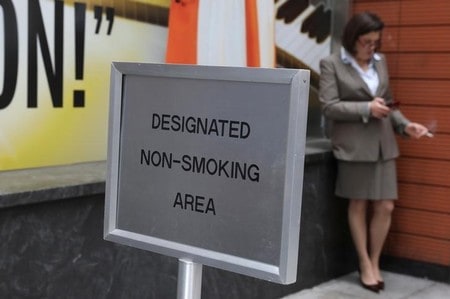By Tamara Mathias
(Reuters Health) – Court-ordered anti-smoking ads sponsored by the tobacco industry reached only around 40% of adults and about half of all smokers in the U.S., a recent study suggests.
Past research has shown that anti-smoking mass media campaigns are an effective public health intervention and work to reverse misconceptions, researchers write in JAMA Network Open.
In 2006, U.S. District Judge Gladys Kessler ruled in favor of the Department of Justice in a lawsuit against the tobacco industry, requiring cigarette companies to sponsor anti-smoking advertisements in major newspapers, television, retail displays, cigarette packages and their corporate websites in order to “correct” misleading messages the industry had been putting out for decades.
After years of further litigation and appeals, the industry began running newspaper and television ads in November 2017.
To assess the reach of these ads, researchers led by Sanjay Shete of the University of Texas MD Anderson Cancer Center in Houston surveyed a nationally-representative sample of 3,484 adults between January and May 2018, during which time the ads were running.
Participants were asked whether they recalled seeing ads specifically mentioning that a federal court had ordered tobacco companies to make statements about the dangers of smoking cigarettes.
The survey also asked if people remembered seeing ads focused on one of five specific dangers of smoking: the harms of smoking; of inhaling second-hand smoke; addictiveness; cigarette design that enhances nicotine delivery; and the lack of harm-reduction with light or low-tar cigarettes.
Only 40.6% of adults recalled seeing the advertisements. Exposure was even lower among certain ethnic and socioeconomic groups historically targeted by tobacco industry marketing.
Just 37% of people aged 18-34, about 35% of those with no more than a high school diploma, and 38% of those with household income under $35,000 a year reported having seen any of the ads.
Around half of current smokers had seen one or more of the ads, but in this group, just 42% of Hispanic smokers had seen them.
The study authors note that a three-month antismoking media campaign entitled Tips from Former Smokers, which was run by the federal government, reached 80% of current smokers despite its much shorter duration compared to the tobacco industry’s campaign.
“Anti-smoking campaigns run by the U.S. Centers for Disease Control and Prevention or other government organizations in the past seem to have had a much greater reach,” Shete noted in a phone interview.
“It is possible that young people are no longer watching TV or reading newspapers, and are getting their news on social media,” he noted.
Yale University neuroscientist Marina Picciotto said it wasn’t surprising that the tobacco-industry designed and sponsored ad campaigns did not reach the “most vulnerable” users.
“The tobacco industry has been several steps ahead of regulation since the first Surgeon General’s report showing that smoking is responsible for large-scale death of its users,” said Picciotto, who is former president of the Society for Research on Nicotine and Tobacco.
“Compliance with a court-ordered advertising campaign could be designed with an eye to keeping the message away from the eyes of their most valuable consumers.”
Because the survey data was elicited in batches, researchers were also able to determine that people who responded several months after the campaign was run were more likely to have seen the advertisements.
“Two takeaways from the data are that advertisements need to run over long periods in order to reach more people and that the media used to broadcast them needs to be selected carefully to reach the most relevant target audiences,” Shete said.
“Tobacco industry-funded public awareness campaigns shouldn’t be a one-and-done thing.”
SOURCE: https://bit.ly/2TyWNsJ JAMA Network Open, online July 12, 2019.


